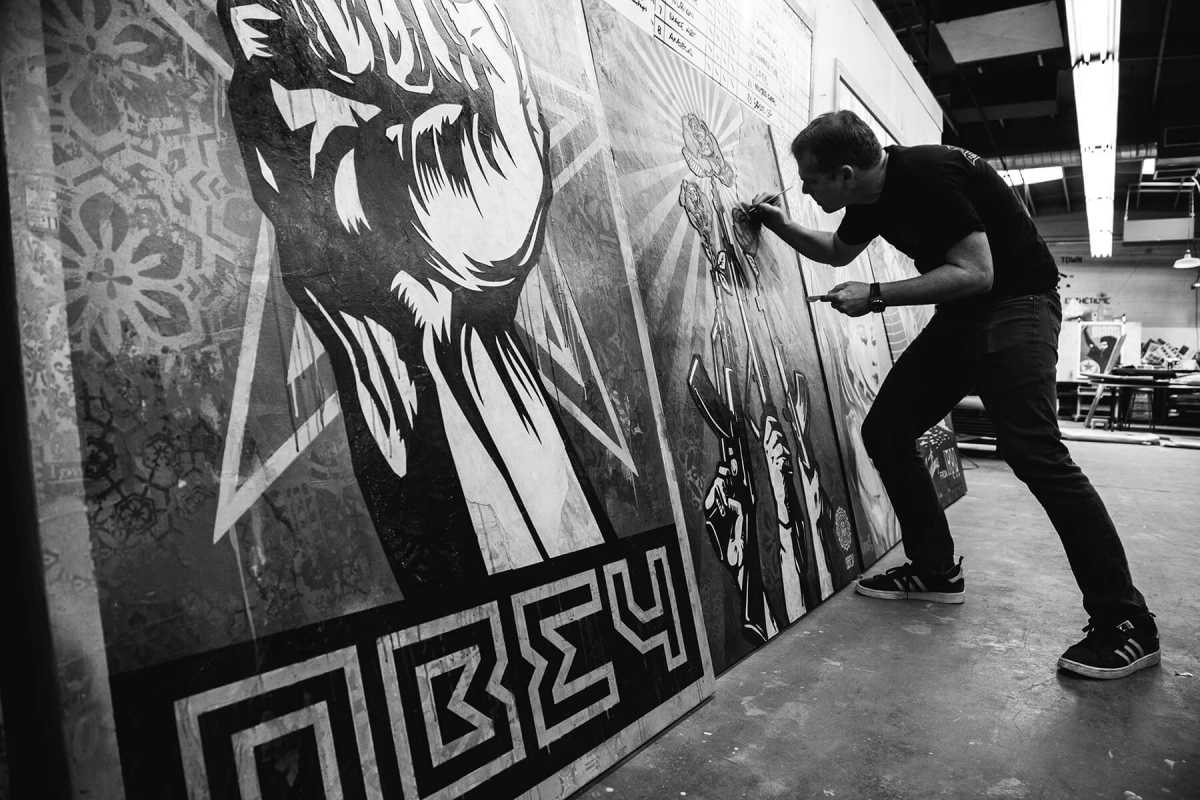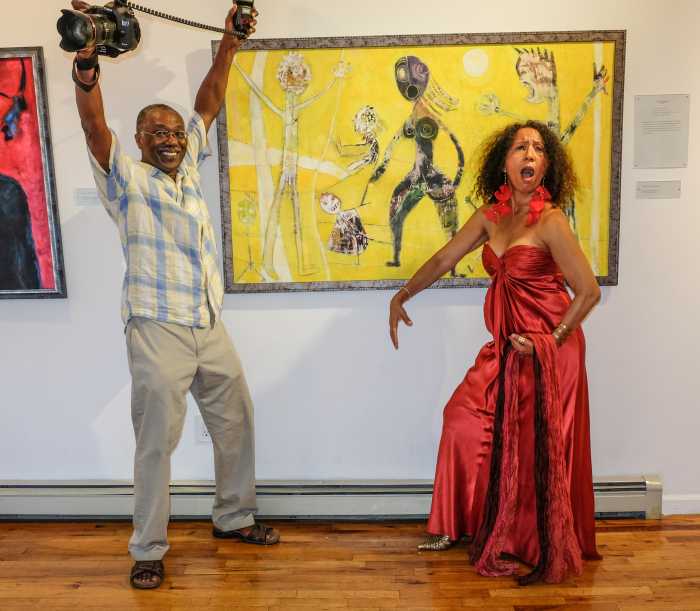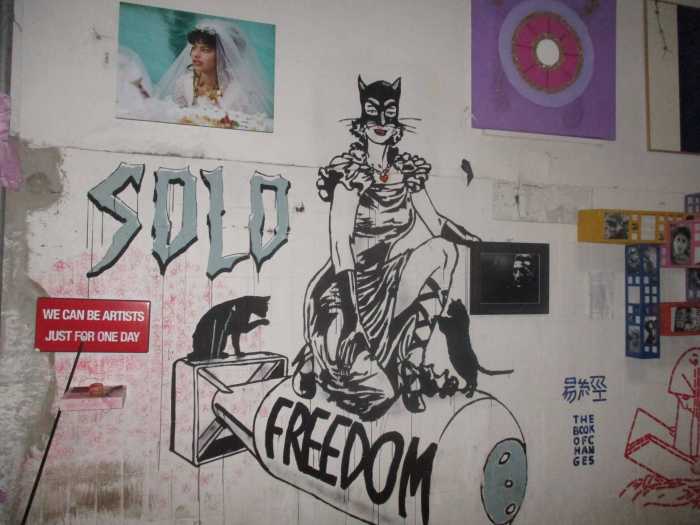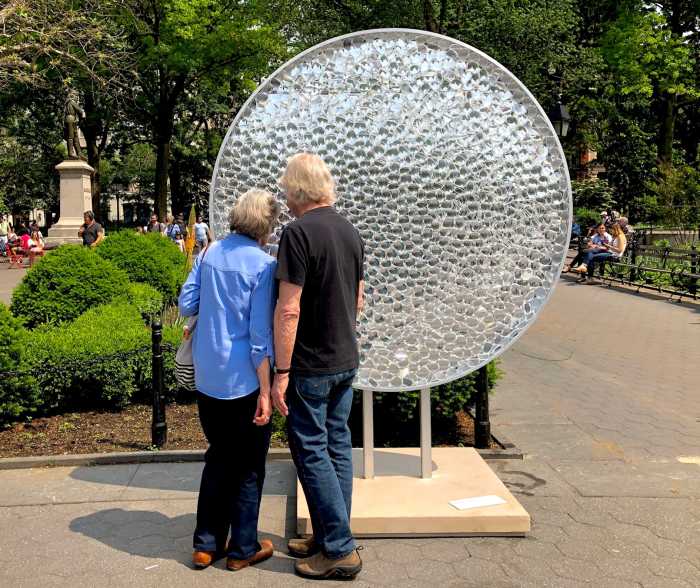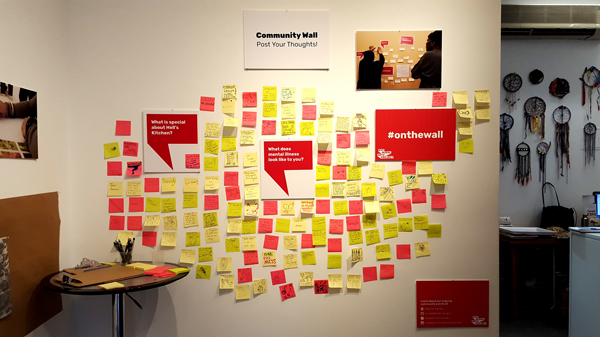Street art fans brace yourselves for one of the most exciting yearly presentations of the genre. Although the event, curated by Roger Gastman, will be virtual this year, you can watch the fair via the NTWRK app with the additional silver lining being that viewership will be enlarged. This truly illuminating experience will showcase not just big names, such as the inimitable Shepard Fairey, but also lesser known—but nonetheless brilliant—working artists such as Maya Hayuk, Joe Conzo and 100+ other rare talents. Be inspired, find yourself thrilled and, most importantly, find ways to appreciate life through art as a counterbalance to our truly frightening real world.
Iconic artist Shepard Fairey discusses the intersection of art and political action
HS: You have often described your art as a mixture of commercialism and activism—with the former providing the means to spread the messages of the latter.
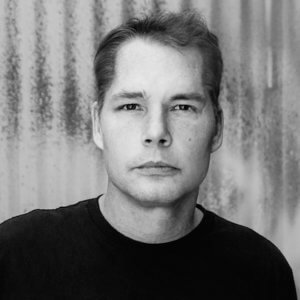
Recently, you completed a giant “Use Your Voice!” mural in Milwaukee, Wisconsin, a swing state. The mural was presumably designed to combat voter disinformation, empower voters and set straight a distorted and confusing political process. Do you think it was successful for those who feel utterly disenfranchised by the two-party system?
SF: I hope that some people would re-evaluate the importance of voting and consider it an important means of empowerment, even if they have some cynical feelings about the nature of the two-party system. I’ve been both impressed and depressed by the myriad creative excuses people use to say their vote doesn’t matter. Still, I’m always trying to create compelling counter-arguments to that with my imagery. I think the Wisconsin election results and robust voter turnout are good signs, even though I can’t say how much of a role my mural played. If it played any part, then it was worth the effort.
HS: You have done something at each of past BEYOND THE STREETS [BTS] events? What about the event are you most excited about? Even though this year’s event is virtual, how important are these kinds of collectives for giving birth to and sustaining groups of like-minded, or even the coming together of disparate artists?
SF: I think the need to make the content exciting, despite the remote format, forced people to be creative in different ways. The street sign I made, an upside-down Yield sign called “Unyielding,” was exciting for me to create as a way to connect to the street and the idea of the meanings of signs and symbols we encounter. I’m also very excited that I got to do an extensive interview with the artist Pushead because Pushead has worked with some of my favorite bands, as well as Thrasher Magazine and Zorlac Skateboards, so his art was part of a visual soundtrack of my youth. I’m really excited to see the content and limited pieces created by the other artists.
HS: Do you believe in artistic collaboration between creators using different media—which I imagine is a major benefit of events like BTS—or are you more of a “lone wolf”? What are the benefits of collaboration?
SF: I love collaborating because I get to work with people who’s art I admire, and it forces me out of my comfort zone to find new solutions to making our work join together harmoniously. As an artist, I think it’s very easy to fall into past formulas, so collaboration can be a great driver of evolution and cross-pollination between artists’ audiences. That being said, I get restless and want to evolve even when I’m working by myself, so I use a lot of experimentation and trial and error to make breakthroughs with new aesthetics and techniques. Those are often building on top of a significant number of things I feel I’ve developed successfully up to that point.
HS: Has the internet’s oversaturation of politics, throwaway images, presidential Tweets and sound bites in everyday life—the memes, the gifs, the lies, the endless dross—had an affect on political art? Has it acted as a launching pad for the creation of political / cultural art or had a detrimental effect?
SF: The internet has democratized things and created a lot of white noise in both images and messages. Despite that, the principles I’ve embraced with my work from the beginning of my career still stand strong. I think it’s important to make images that are bold, impactful, and able to cut through the media overload we are all inundated with. I began my career by creating images that could compete with the dense urban landscape. I think that’s served me well in distilling images and messages to their most potent essence for other realms, including the internet. There is a lot to compete with, and I think that people are often so fatigued that they lose the capacity to process images and ideas or being excited by them when they feel overwhelmed. Sometimes resonance is luck, but luck favors the well-prepared, so I always try to have my imagery and messages ready to be placed into any context where they might make a difference. The internet included, of course.
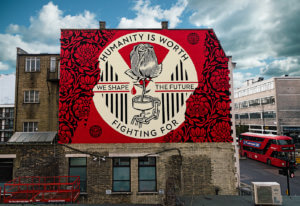
HS: Do you think there is too much elitism in art? Both in those that create it and those that view it / buy it just because a classic or renowned painter’s name is scribbled on it? You talk about Heidegger, I have a Master’s degree in Philosophy, until adulthood I was largely self-taught and quite frankly intimidated. Should be take elitism out of art, teach or children better or alternatively, let them start their own movements, unencumbered by the weight of erudite tradition?
SF: I have mixed feelings about the art world. I’m not a fan of pandering to the elite or adhering to structures dictated by the elite and powerful. Philosophically, I’m much more into the empowerment of the disenfranchised and the democratization of art (and everything else). That being said, I think the art world has its place because affording the time to create labor-intensive art objects can only happen when there are outlets for and a market for more expensive art. I take a multi-platform and multi-tiered approach to my art, so that engaging with the elite art world is only a fraction of my practice. I’d like to see art practiced more widely so that it’s accessible as a tool of empowerment and something to live with in one’s home. In my youth, do-it-yourself movements like punk rock, skateboarding, hip hop and graffiti inspired me, so I’ve always thought it’s more exciting for young people to create their own movements and their own art without the burden of art history or elitist gatekeepers.
HS: After becoming such an iconic artist, do you ever miss your renegade punk / skater years? Or is helping to inform people more important? There’s a Ruth Bader Ginsburg quote I love that reminds me of your ethos of not just existing to make people think, but to encourage them to act. Ot goes, “Fight for the things that you care about. But do it in a way that will lead others to join you.”
SF: When I was young and broke, one of the only forms of empowerment and therapy I had was renegade art, but even then, I hoped that my work could encourage people to question things and take action. As I’ve become more established, I try to use my connection with an audience as constructively as possible, knowing that ideally everyone has their own voice and their own vision that won’t look or sound just like what I’m doing, but maybe my work can provide a model. I still think like an outsider, but I’ve got access to the system a lot more than I used to, so I employ what I call the “inside / outside strategy.”
HS: Do you miss non-commissioned street and illegal graffiti as opposed to “post-art,” of the kind being shown at BTS? Or do you think this is a huge step forward for the art form?
SF: I don’t think it’s binary. Many of the people who are part of Beyond the Streets still do work on the streets, and many people who are just working on the street now, will eventually have traditional art shows and do other things other than just graffiti. I’ve always looked at art as something that should live in many places and be fearless. Naturally, with that philosophy, working in the streets always has and still makes sense to me, but speaking only for myself, I’d feel narrow-minded. Like I was squandering opportunities if I only worked in the streets. Other people might feel differently, but I think good art is good art wherever it is.
HS: If you had to make an image, or images, depicting 2020, what might that look like?
SF: This might sound like I’m deflecting the question, but 2020 has not been monolithic. There have been very heavy upsetting things about the suffering people have faced due to illness or economic strain during the pandemic. There’s been a huge amount of political polarization around things like racial justice, the right to healthcare, and other things, but I’ve been very happy to see the number of people and the diversity of people who want to defend Black lives and dismantle white supremacy, and the number of people who have been compassionate and generous during COVID. COVID is a problem we have to solve together, so I’ve been frustrated by the political divisions around the pandemic itself. But I’m optimistic that the collective sacrifices needed to get through COVID will benefit us in tackling other problems such as climate change. I think all of that is impossible to encapsulate in one image.
Felipe Pantone, BTS Creative Director, and masterful, unique and technologically advanced Argentinian/Spanish artist and muralist
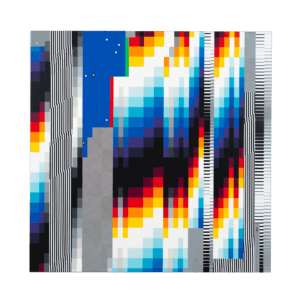
You started doing graffiti age 12? Can you tell me the story of what led to that and where were you living? In general, do you think it’s common for graffiti artists to catch that bug at a young age? Does this help encourage artistic growth in later life?
Absolutely, it’s the most common thing to catch the bug at a young age since it always starts as a game. For most graffiti writers it always remains as a game. I was living in Torrevieja, Spain, and graffiti was everywhere in my neighborhood growing up. In my particular case, the lifestyle I experienced in graffiti, all the traveling, being connected to many people across the world, the sense of immediacy, ephemerality, impermanence, is in essence what ended up being my artistic discourse. In that sense it can be said that graffiti encouraged my artistic growth.
Your art is extremely unique. How does it fit in with BTS and are there any artists who will be at the event that you feel you have an affinity with, or look forward to productive discussions and / or learning from? What is a (non-obvious) red thread that connects the distinctive artists that participate in BTS?
All of the artists in the event have something in common: they all come from graffiti or have a connection to the streets. Many of them are my friends, some I still don’t know personally, and others I’m already connected with via internet. Graffiti was to many of us a feeling of belonging to a universal brotherhood. We were able to travel to any city, meet with locals, crash at somebody’s couch, get paint, be taken to a wall or a train, and later party in the same style as if you were at home. BTS is about artists that developed the most diverse studio practices, but somehow we all carry with us that DNA that started on the streets.
Looking through the website, your ‘Artifact to Artifact Communication’ installation looks as thought provoking as it is dynamic. What can you tell me about it? Do you see the ability of not being to engage with 3D installations as a drawback of this year’s virtual show?
Human-to-human and human-to-artifact (i.e. me typing on this computer), are the most common types of communication. My installation “Artifact to Artifact Communication” that I presented at BTS in Los Angeles in 2018 underlined the new possibility: machine learning, artificial intelligence, and technological singularity. Most of my works aim to bring awareness about themes that are intrinsic to our present times. Definitely physical art, museum size installations, and getting to see the work in person allow the strongest communicative impact. However, the internet nowadays, specially a platform as powerful as NTWRK [the app you need to download to watch the virtual art fair], can create a really interesting experience, stream video and allow the audience to comment and get involved. Also, the fact that the artists together with BTS created many physical pieces that will make the art more accessible than ever even from the distance.
Was it difficult to refine your skills to the degree necessary to create works such as “Chromadynamica”? How did you learn about chromodynamics? You use not only complex technology but also extremely complex theory in your work.
My “Chromadynamica” series makes a nod to the quantum chromodynamics theory, however instead of using the prefix chrom- or chromo- I use the whole Greek word chroma. In these works I literally play with color and dynamism, creating displacements, and combining infinite variations that suggest movement of colored pixels.
How important is it that art continues to evolve alongside technology? It seems like a natural course, so what would the alternative to that even be?
As you said, to me is only natural to make use of any technique available to best communicate what I want to communicate. In my case, I’m always looking for what is new that can help me transmit my discourse in the sharpest way possible.
Is it more important for an artist? To be innovative than to be emotionally moving—or are the two not mutually exclusive?
As an artist and also an art consumer, the sweet spot is in the balance of those two concepts. On one hand, art has to move me, speak to me, inspire me, and make me think. Art History is an endless book that’s constantly being written. There’s no point to write the same things over and over. Innovation is key in order to provoke inspiration and food for thought.
Joe Conzo: ‘Born in the Bronx’
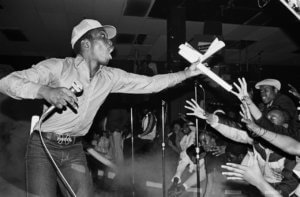
Without artists being able to take part in traditional shows this year—what does BEYOND THE STREETS bring to the art world?
With the traditional norm all but gone this past year, BTS has been able to think outside the “box” and still provide a vehicle for artist such as myself to continue to promote and share our works with the public. With the arts hit so hard this past year, BTS continues with very few boundaries, if any, to provide a platform for artists to still be artists and share their work with the world!
What is your contribution to the show?
My contribution to the show is the release of an expanded version of my book “Born In The Bronx,” first released in 2007. A one of the most sought after Hip Hop books ever released, BTS, along with 1XRUN, Rock The Bells and Boo-Hooray Gallery, made it possible to give the world another chance to own this classic book.
How have NYC artists responded to the world this year?
NYC artists are resilient and always looking for ways to share their art and supporting each other! As a photographer, it’s about respecting the art form and its elders and supporting the younger generation. BTS has been that and continues to be that platform for artists from all over the world!
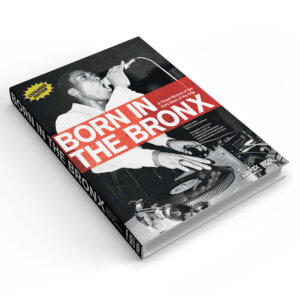
Maya Hayak: Vibrant artist and activist
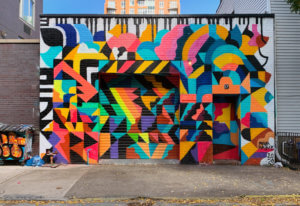
Without artists being able to take part in traditional shows this year—what does BEYOND THE STREETS bring to the art world?
BTS has jump-started the online art show experiences as a viable and real way to engage with art. We didn’t have as much of an imperative before lockdown to rely on a model like this, even though we already consume so much online. They, like the artists and other innovators are flexible and quick on their toes. I’m sure we’ll be seeing a lot more of this kind of art show in the future, but the brick and mortar experience won’t be supplanted. Ultimately, BTS is opening doors and windows and breaking down walls that we will all benefit from.
What was your past experiences showing at BTS?
Pretty incredible. I’ve always been astounded by what BTS has created and can achieve and it’s an honor to be a part of the movement.
How have NYC artists responded to the world this year? What did you do?
We all had to change plans and figure out basic sustainability for ourselves and for our communities. All of my plans to travel outside of the US for mural commissions were cancelled. Only one of the numerous US commissions came into fruition in Toledo, Ohio. I switched gears into working on my rooftop and on walls within walking distance. I started making piles and piles of sharpie drawings, painting on bandanas and playing way too much Sudoku. After George Floyd’s murder, I started making protest posters with the artist Snoeman, which we would spray paint up on my roof and throw down to activists who’d pass by. We made hundreds of these posters, which was a natural response that a lot of artists had: “Where am I needed? How can I help? What can I do?”
A few extra examples of BTS art on display to ignite your visual tastebuds
BEYOND THE STREETS is a two-day virtual art fair featuring world-renowned creators taking place this weekend, Dec. 5th and 6th, and is viewable via the NTWRK app. For more information go to www.beyondthestreets.com



